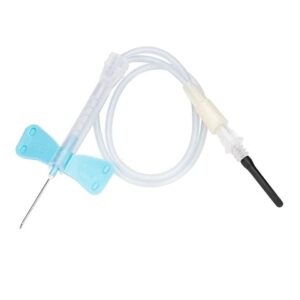 My aunt was in the hospital for a few days (nothing major, except when you’re pushing 98 everything is major)). To a one, the staff at the hospital were wonderful–competent, kind, empathetic, and sometimes, funny. But a lot of the time my aunt was dozing off–hospital life not being a thrill a minute, even with your favorite niece on premises–and I found myself looking at all the things.
My aunt was in the hospital for a few days (nothing major, except when you’re pushing 98 everything is major)). To a one, the staff at the hospital were wonderful–competent, kind, empathetic, and sometimes, funny. But a lot of the time my aunt was dozing off–hospital life not being a thrill a minute, even with your favorite niece on premises–and I found myself looking at all the things.
I’ve always been fascinated by medical technology, but particularly the small stuff: the clips that hold IV bags in place but also serve to gather up the tentacles of tubing so that the patient and staff aren’t constantly tying themselves in knots; the plastic sheet with straps that slides easily over the bed, so that a patient can be moved easily and with less stress on her and her caregivers; the astonishing doohickey that the hospital uses to help move mostly-bedbound patients to a recliner or wheelchair; the contraption that helps my recuperating daughter pull her socks on without bending in medically unadvisable ways. None of these things are going to make history, but they make the lives of people who are sick or disabled, and the lives of their caregivers a little easier.
It pleases me to think that there are people out there who spend their days coming up with these gadgets. Probably some of them were invented by caregivers or people who work in hospitals. My father, who was a volunteer Emergency Medical Tech for twenty years, was one of those folks. At the time each ambulance had reusable medical-grade splint. If the splint was used during a call, they had to wait until the patient had been stabilized and the splint had been cleaned and disinfected before they could use it again. In a community with a number of ski-slopes and lots of winter sports, more than one broken limb in an afternoon was not exactly unheard of. So my father (who was an artist, industrial designer, and unstoppable tinkerer) came up with a lightweight, inexpensive disposable splint. He patented it and found a manufacturer to license it, and he split the proceeds with the ambulance squad. That was 30 years ago, and I suspect that Dad’s splint has been rendered quaint by subsequent inventions. Even so.
When I used to give platelets I was the weirdo who asked the phlebotomist all sorts of questions about the bits and pieces of tech that were used, not only to test my blood for iron before I gave lots of it away, but to make the process easier for the technician and more pleasant for the blood source (which would be me). Not least of which is that stretchy mesh bandage that comes in a rainbow array of colors. “What color would you like today? Purple? Green? Neon pink?”
There are downsides, of course. Most of these things are meant to be used once, which means that they are small, probably relatively cheap, and made of plastic. I worry about the sheer amount of plastic that is added to an already-overburdened planet in the name of doing health-related things safely and easily, without the need for sterilization and re-use. I would be a little leery of, say, compostable plastics used for things like IV tubing or test tubes. Maybe for some of the comfort- and transportation-devices? I don’t know if any of the hospital-use plastics are recycled, but it would make me very happy to know that they were. And the Big Plastic Things (like the iMove patient mover chair I linked to above) are durable equipment, meant for many uses, and at the end of their lives could be recycled.
I want–I applaud–all the clever gizmos that busy minds can devise to be used and improved and to make our lives better. I also want, because having it all is my watchword, for those things to leave as little trace as possible for the next generations. It’s only fair.
